Friday Forgotten Film: In Harm’s Way
“A fast ship going in harm’s way.”
I know the reasons I teed up one particular 1965 war film for a viewing this week. We are about to enter the Memorial Day weekend here in the U.S. and it lends itself to remembering the men and women who died while serving in our armed forces. The second was due to my colleague Colin’s splendid review of an Otto Preminger film I’m waiting to get at, Fallen Angel. Most of this director’s productions I’ve come across over the years have always been watchable, if not his knack of taking on controversial and/or challenging subject matter. Never were they boring.
A couple of them I caught on local TV channels while staying up late some Saturday night when my grandmother had already gone to bed. Yes, I’ll admit she spoiled me. So? It’s said the Austro-Hungarian-American was known to be tyrannical on set. Add him to that long list, I guess. Most critics and film historians reckoned his peak years occurred during the 40s and 50s. Laura, Forever Amber, Carmen Jones, Porgy and Bess, Anatomy of a Murder and others landed within this period.
Even when his films began to experience critical and financial failures in the mid-60s, Preminger’s still held your eye and interest. Likely the initial film of these so-called bombs would also be the first of his I actually saw on the big screen at the local movie theater — In Harm’s Way. It’s my contention the film’s forgotten somewhat because it’s not listed among either the director’s or the film’s leading man’s best. That’d be unfair for it was a better drama than given credit, perhaps even disregarded because of its war film heritage.
“Well, we all know the Navy’s never wrong. But in this case, it was a little weak on bein’ right.”
Based on James Bassett’s well-regarded ’62 bestseller, Harm’s Way, it detailed the early, painful months in the Pacific at the start of World War II, right before and immediately following Pearl Harbor. Primarily, told through the lives of a handful of the naval officers, along with their wives, lovers, and girlfriends, taking the brunt of being “…caught in a vacuum between a peacetime Navy and a wartime Navy.” Especially, whenever within the frame of two people finding their way with one another. Its unlooked-for strength in dramatic storytelling was what people missed.
Not the grand sea battles most came expecting, but with the relationships fraying and coming together directly due to a world at war.
For an epic film, one that used the state of Hawaii as a prime location, it was the intimate scenes that really carried the film. If you watch this, you’ll discover its best moments were almost always among the quiet conversations between just two people on the screen. More than likely in some room, tucked far away from the apparatus of war. Oh, yes. There’s melodrama clearly about. Perchance, too much as some critics back in the day lamented. But that ignored some powerful, low-key performances, a number of them in its star-laden cast.
Such performances like John Wayne‘s Rockwell ‘Rock’ Torrey and the ever-stalwart Patricia Neal, through her nurse Maggie Haynes role, in particular stood out. Wayne, now older (and seriously ill with his first instance of lung cancer) in appearance by this point of his career, in an already turbulent decade, certainly gave one. His character more apt to make and admit mistakes than simply take charge, or names, and save the day like his 40s war films. So, too, with Neal’s career Navy nurse who was her own, and others, the real “rock” figuratively in troubled times.
One who displayed a practicality and knowing her cohorts routinely dished away, as youth is always wont to do:
“Annalee dear, past a certain age, men are apt to avoid making sudden moves where women are concerned. The women have to do the sudden moving, or else everybody stands still until it’s too late. It gets late fast in these times. I like this man, and I want him to know it — now.”
The matched set gave us an older, weathered courtship with bittersweet desperation — both mature and only too well aware it’s likely their last chance at love. Plainly, their interrupted pairing made the film’s final scene, after the obligatory action and sacrifice invested in wartime films, that much more affecting.
In Harm’s Way offered a portrayal of people picking themselves up after getting knocked down, making their way to the start-line of a long bloody slog before them. Taking their lumps and losses right along with their country on the cusp of a conflict that would stretch across thousands of miles of ocean. A history that had losses lined up and coming till the battles of Coral Sea and Midway arrived.
The struggle sketched across the largest body of water, the Pacific, the planet had to offer, and both a witness to the clash of countries and completely indifferent to it all. The film’s tale situated mostly in the rear area and backwater alleys of a war gearing up for its main players, General MacArthur and Admiral Nimitz. Preminger’s film threw the rare spotlight on to those history would overlook with nary a second thought.
Screenwriter Wendell Mayes gave Bassett’s knowing words (the novelist spent the better part of his WWII duty working for Admiral Halsey) a respectful adaptation. Unquestionably, it was a distinctive script that gave a number of well-known actors in the cast a chance to chew a bit of scenery along the way. Of course, Kirk Douglas as Commander Paul Eddington, got the most bites at the apple. He as Torrey’s chief aide ran the gamut of emotions as he did in so many roles. From a drunk, staunch ally, to a maniacal rapist and finally naval hero. Scene…start chewing.
Douglas offered a unique foil to Wayne’s approach with a character. He’d be the prime reason to watch their next collaboration together two years later in the lesser-tier western of the day, The War Wagon (later, Wayne would do “…a cameo in Douglas’ ode to Israel, Cast a Giant Shadow“, as IMDB noted). Put me down, too, as a long-time admirer of Paula Prentiss, who worked marvelously off Wayne and Tom Tryon (who as it happened followed Preminger over from their stint together in The Cardinal) in scenes. Though, she had only a small intersecting supporting role, Paula always left the viewer craving more screen time with her in it.
Add in an older but still solid Preminger-veteran Dana Andrews, the ever capable Burgess Meredith, Henry Fonda doing his first interpretation of Admiral Nimitz (a role he’d repeat the next decade over in Midway), and Patrick O’Neal, whose smarmy character gathered the best slap-down ever delivered by Kirk Douglas in a movie. Churn them altogether with some hopefuls of the day (Brandon De Wilde, Jill Haworth) along with some extraordinary character actors (Stanley Holloway, Slim Pickens, an emerging Carroll O’Connor and George Kennedy) and there was no shortage of talent associated.
“All battles are fought by scared men who’d rather be someplace else.”
The big budget Paramount studio production was wonderfully shot in keen black & white by DP Loyal Griggs, which may have been what discouraged many ticket buyers of the day looking for brightly colored heroism. Not the unglamorous grayscale of duty many were pressed into during a time when called upon. No doubt, the cinematography added a seriousness to the events at hand that didn’t distract from the material. In fact, it only enhanced, via sharp relief, the character-driven piece, I think.
This more modern, at least for the 60s, look stood in contrast to a number of war films produced during the 40s.
Yeah, it certainly was not in the same class as Laura, Bonjour Tristesse, Advise and Consent, and for sure Anatomy of a Murder (which I also screened this week) by this storied filmmaker. Yet, In Harm’s Way was by no means anything close to inferior work by Otto Preminger. In fact, it stood head and shoulders above a great many more jingoistic films lauded upon decades before.
Want to hear deft dialogue and see relationships pulled taut, with less big guns and effects shooting off, in your wartime movie watching? Then, this is your film. Sure, it’s got romance, infidelity, and threadbare father/son ties. Hell, even rape, suicide, and enough death in the performance of duty to fill out multiple dance cards. Yet, In Harm’s Way also had characters with a sense honor and courage we all hope we’d have given the same situation, even if they were as flawed and as scared like the rest of us. It’s an unexpected war film worth remembering, especially this Memorial Day weekend.
“Old Rock of Ages, we’ve got ourselves another war. A gut bustin’, mother-lovin’ Navy war.”

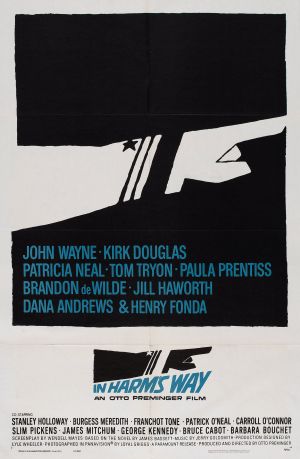
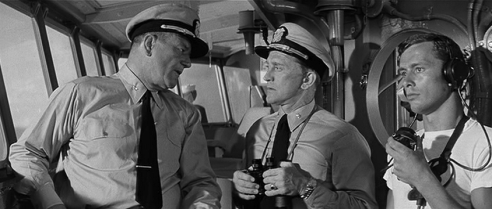
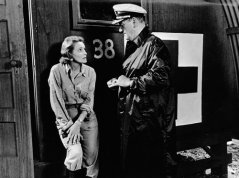
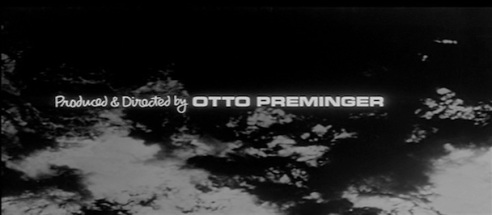
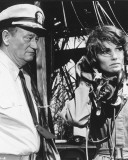
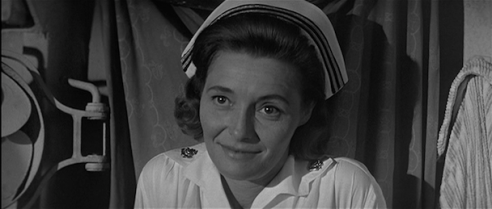
22 Responses to “Friday Forgotten Film: In Harm’s Way”
I am one of those that failed to fall under this movie’s spell when I did catch up with it on TV a few years ago, finding it somewhat turgid and hard to warm to. As you say though, there is much to admire (not least a fabulous score by Jerry Goldsmith) and it deserves a second look, which i will certainly do.
LikeLike
Yes, it won’t be everyone’s cup of tea. Good point on the always reliable Jerry Goldsmith and his score. Thanks for the read and comment, Sergio.
LikeLike
I’ve always overlooked this whenever it was on TV, Michael but with that cast maybe I shouldn’t. I’m not Wayne’s biggest fan but I like the rest. Especially Meridith and Fonda.
LikeLike
I understand about that he may not be a favorite, but Wayne is quite different here and really stands out when paired when Kirk Douglas and Patricia Neal. Give it a try. Thanks, Mark.
LikeLike
Nice piece Michael. I haven’t seen this. Like mark, I’ve always overlooked it but I should probably give it a try.
LikeLike
Please let me know what you think of it after screening, TM. Thanks so much, my friend.
LikeLike
Hi, Michael:
Preminger’s ‘In Harm’s Way’ is a decent war film. Not a great one. Though well worth the time. More immersed in characters than action. While offering a neat perspective to those Navy officers on the wrong end of the attack on Pearl Harbor. On through Guadalcanal and the Battle of the Coral Sea.
Wayne and Douglas more than hold their own. With Douglas far in the lead as a troubled officer with serious issues. While Patricia Neal steals every scene she shares with the Duke. And the supporting cast all have their moments to shine.
Still love the scene where Douglas politely slaps the crap out of Patrick O’Neal ‘s snotty, scheming Commander Neal Owynn and convinces him to leave prior to a major operation.
Good work, my friend!
LikeLike
Well said, Kevin. And wasn’t Patricia Neal magnificent in this? The more I re-watch this, she (as you say) “…steals every scene”. And if I ever saw Patrick O’Neal and Kirk together, I’d expect Douglas to slap him ;-).
Thanks so much for the comment, Kevin.
LikeLike
Hi, Michael:
Patricia Neal subtly and sometimes overtly rocks out loud in ‘In Harms’ Way’. Especially opposite John Wayne. And when offering poetic advice to Jere’s fiancee, Jill Haworth before she meets Eddington.
All the ladies in attendance work well within their characters. With Paula Prentiss standing out as Tom Tryon’s wife, Bev.
LikeLike
We’re simpatico on this, Kevin. Thank you my friend.
LikeLike
Firstly Michael, thanks for that link at the top of the review.
Now to the film. Directed by Preminger and starring Wayne and Douglas, this ought to be one of my favorites. For all that, I can’t honestly say it is. The subject matter – the tough early years of the war – is fascinating, and the acting can’t be faulted. There’s much to like here, as your piece makes clear, but it didn’t really come together for me.
I think that, ultimately, the problem I had with the movie is the mix of a war story and the soapier elements. I know the latter is there to build up the characters, but it weakens the former for me anyway.
It’s by no means a bad film, but it’s nowhere near the best the director or stars were capable of either. It’s one of those movies that contains elements and scenes that I like quite a lot yet doesn’t really satisfy me when taken as a whole.
Having said all that, it’s been a while since I last saw this one, so I guess I should give it another go and see how I react this time. Either way, that’s a fine article you’ve written here and it does a good job of highlighting a film that is often neglected when the work of Preminger, Wayne and Douglas is discussed. Thanks for flagging it up.
LikeLike
I appreciate your deft comment, Colin. I do think it a neglected film, if not perfect, worth a look for the professionals involved at a unique point in their lives and for the subject matter. Many thanks, my friend :-).
LikeLike
John Wayne, Patricia Neal, Henry Fonda, Dana Andrews…how have I not seen this? I’ll be watching out for it now. Thanks Michael.
LikeLike
It’s worth a look, Paula. So many great pros in the cast doing overlooked work. Thank you very much :-).
LikeLike
[…] is the Memorial Day holiday, I’ve made a habit of watching war films in remembrance of the men and women who died serving this country. Two of Powell’s were such, […]
LikeLike
I own this move and think it is excellent. There is a simplicity and nice pace to this movie. I guess I like the way things go done then versus the stark reality of today. It is one of those movies that just makes you feel good. d
LikeLike
Welcome, and good to find another fan of this underappreciated Preminger film. Many thanks 🙂
LikeLike
[…] With larger screens and more convenient ways to watch films, theaters must continue to adapt to meet the demands of the consumer. Nonetheless, a night out at the movies remains an exciting experience that offsets the mundane nature of everyday life.The hits keep comin’: Friday Forgotten Film: In Harm’s Way […]
LikeLike
[…] is the Memorial Day holiday, I’ve made a habit of watching war films in remembrance of the men and women who died serving this country. The war film makes for […]
LikeLike
[…] across TV (McHale’s Navy, Bonanza, Gunsmoke) or movies (Hush…Hush, Sweet Charlotte, In Harm’s Way, The Flight of the Phoenix) that decade. Highlighting that mug of his, and a distinct personality […]
LikeLike
[…] personal, emotional, and on occasion, for sheer entertainment value. From sea and personal battle, In Harm’s Way, below that surface with The Enemy Below and Run Silent Run Deep, and to the specter of […]
LikeLike
[…] William Wyler (The Big Country), and Otto Preminger (Carmen Jones, The Man With the Golden Arm, In Harm’s Way) to name only a few, let alone the movie posters he fashioned or the corporate logos he […]
LikeLike